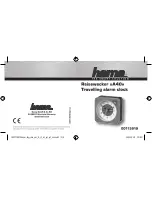
Masterclock
www.masterclock
.com
29
Minimize Hairline Scratches
Always store the clock face-up in the protective plastic shipping bag until ready for installation and
during transporting to the installation site. Do not place the clock face (lens surface) down on any
surface as this may scratch or mar the lens.
Scratches and minor abrasions can be minimized by using a mild automobile polish. Three such
products that tend to polish and fill scratches are:
1.
Johnson Paste Wax
(Johnson and Johnson Co.)
2.
Novus Plastic Polish #1 and #2
(Novus, Inc.)
3.
Mirror Glaze plastic polish (MG M10)
(Mirror Bright Polish Co.)
It is suggested that a test be made on a very small section of the polycarbonate lens with the
polish selected and that the manufacturer's instructions be followed.
"Don't" - Very Important
Don't store the clock without the protective plastic shipment bag.
Don't store or place the clock face down on any surface, as this may scratch the lens.
Don't use abrasive or highly alkaline cleaners.
Don't use paper towels, paper products, rayon or polyester cloths to clean or dry the lens.
Don't scrape the lens with squeegees, razor blades or other sharp instruments.
Don't ever use benzene, gasoline, acetone, methyl ethyl ketone (MEK), muriatic acid or
carbon tetrachloride on the lens.
Don't clean lenses in hot sun or on very hot days.
Cleaning the Lens
The following cleaning agents have been found to be compatible with the Polycarbonate and
Acrylic lens. Manufacturer's instructions should be followed.
Formula 409™
(Clorox Co.)
Top Job™
(Proctor and Gamble)
VM and P grade Naphtha Joy™
(Proctor and Gamble)
Windex w/Ammonia D™
(Drackett Products)
Palmolive Liquid™
(Colgate Palmolive)
Foreign Substance Removal
Butyl Cellosolve (For removal of paints, marking pens, lipstick, etc.)
The use of adhesive tape or lint removal tools work well for lifting off old weathered
paints.
To remove labels, stickers, etc., the use of kerosene, naphtha or petroleum spirits is
generally effective. When the solvent will not penetrate sticker material, apply heat (hair
dryer) to soften the adhesive and promote removal. Gasoline should never be used.






































